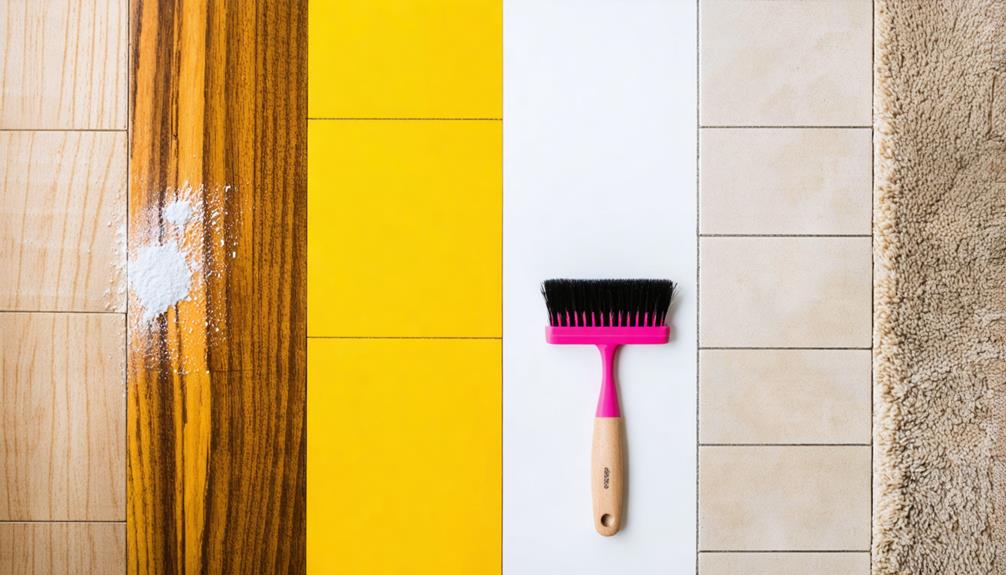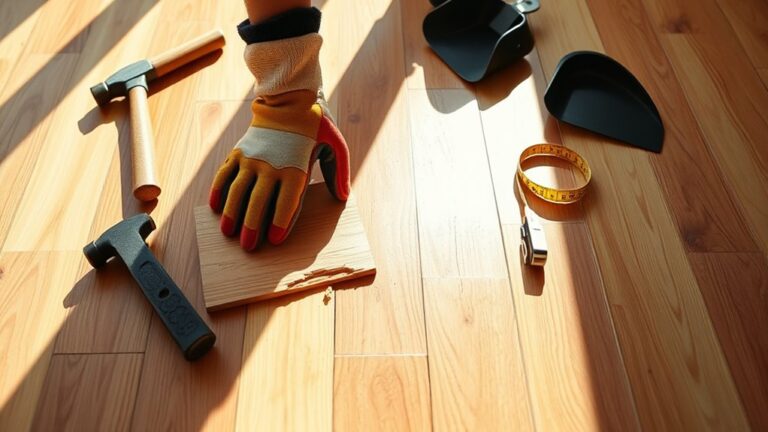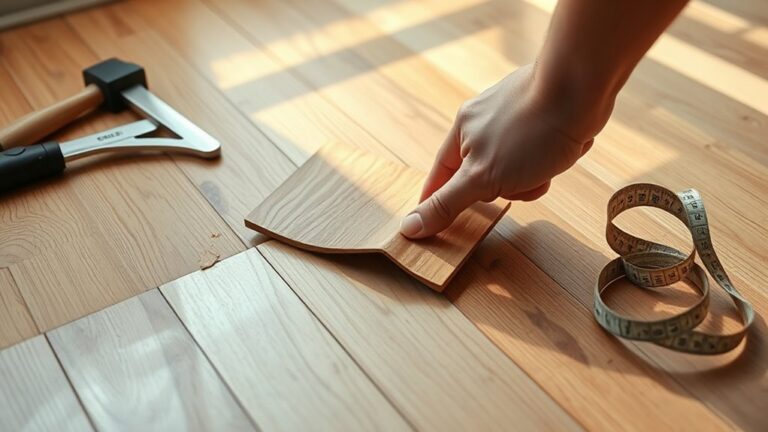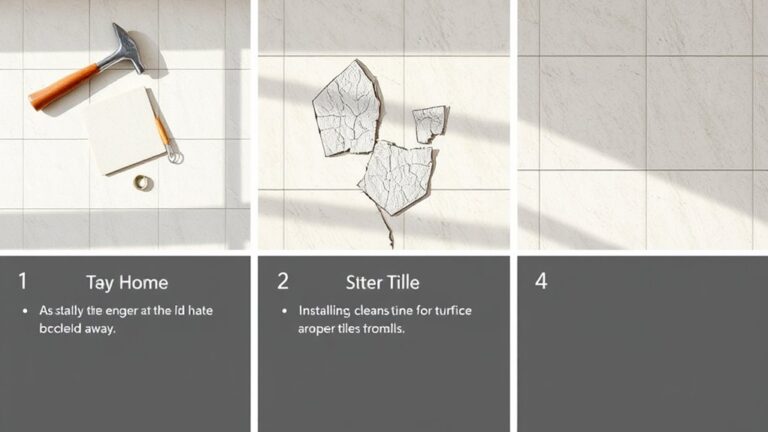To remove paint stains from different floor types, start by identifying the paint type. For water-based paints, warm soapy water usually works well on hardwood and vinyl. If you're dealing with oil-based paints, use chemical strippers and protect yourself. For concrete, scraping and a chemical stripper may be needed, while tile surfaces benefit from vinegar solutions. Dried stains on hardwood often require rubbing alcohol. Always test any cleaning solution in an inconspicuous area first to avoid damage. Want to know more techniques tailored for your specific floor type? You'll find plenty of useful tips ahead.
Types of Paint and Removal Techniques
When it comes to removing paint stains from floors, understanding the type of paint involved is essential for successful cleanup. If you're dealing with water-based paints, you're in luck; these can typically be removed easily with warm, soapy water. Just grab a sponge, apply the soapy solution, and scrub away those stains. However, if you encounter oil-based paint, you'll need to step up your game. Chemical paint strippers are often necessary for effectively removing oil-based stains, so be sure to wear protective gear to keep yourself safe.
For emulsion paints, if the stain is still wet, you can wash it off with water. But, if it's dried, you may need to use paint thinner or even a heat gun—though be cautious with heat, especially if the paint might contain lead, which is common in older homes. Chalk paint is usually water-based and a bit easier to tackle; apply white spirit to remove any wax layers and then follow up with scrubbing using water.
Surface-Specific Removal Techniques
When it comes to removing paint stains, the method you choose depends on the type of floor you have. For concrete, hardwood, tile, and vinyl surfaces, each requires specific techniques to effectively lift those stubborn stains. Let's break down the best approaches for each type of flooring to guarantee you get the job done right.
Concrete Paint Removal Methods
Concrete surfaces can be particularly challenging when it comes to removing paint stains, but with the right techniques, you can restore their original look. If you're dealing with fresh paint spills, start by scraping away the excess using a thin plastic tool. Blot the area with a paper towel, then apply acetone to tackle the stain effectively.
For dried paint, a chemical paint stripper is often your best bet. Choose a product suitable for the type of paint used and follow the manufacturer's instructions closely for best results. If the paint is especially stubborn, utilizing a pressure washer can be an excellent option for outdoor concrete surfaces. It thoroughly cleans the area without damaging the underlying substrate.
Power washing works wonders on driveways or heavily stained areas. However, if you encounter deeply embedded or damaged paint, professional grinding may be necessary to achieve a clean finish. To keep future paint stains at bay, regular maintenance and the application of protective coatings can make your cleanup efforts much easier. With these methods, you can tackle paint stains on concrete surfaces effectively and reclaim their beauty.
Hardwood Floor Techniques
While concrete surfaces present unique challenges for paint removal, hardwood floors require a different approach due to their delicate nature. If you're dealing with wet paint, mix warm water with a mild dish soap and dab the area with a cloth. This helps absorb the paint without damaging your hardwood floors.
For dried paint, start by softening it with a hairdryer on a low setting. This makes it easier to gently scrape away the paint using a plastic putty knife or a dull knife. It's essential to avoid gouging the wood surface during this process.
If stubborn stains remain, rubbing alcohol can be your best friend. Apply it with a cloth and gently rub the area until you lift the paint. For more extensive paint removal, consider using paint thinner or Goo Gone, but be aware that you might need to sand and refinish the wood afterward.
Tile and Vinyl Solutions
Removing paint stains from tile and vinyl floors can be straightforward if you follow the right techniques. For ceramic tile, start by scooping up any excess wet paint. Then, apply a vinegar solution to any dried paint and scrub gently with a soft brush. This method effectively helps to remove the stain without damaging the surface.
If you're working with vinyl floors, hot soapy water is often your best friend. Use a plastic scraper to tackle stubborn stains, but be sure to rinse thoroughly afterward to avoid leaving any residue behind. For dried paint, mix warm water with baking soda to loosen it before gently scraping it off.
Always remember to test any cleaning solution on a small, inconspicuous area first to ascertain it won't cause discoloration or damage. If you encounter tough stains on vinyl, consider using a commercial paint remover specifically designed for that surface. Just be sure to follow the manufacturer's instructions carefully for the best results. With these techniques, you'll regain the pristine look of your tile and vinyl floors in no time!
Techniques for Different Materials
When tackling paint stains on various floor types, it is essential to use the right technique for each material to achieve the best results. For concrete surfaces, if you encounter wet paint, scrape off the excess and blot with a paper towel. For dried paint, a chemical paint stripper or pressure washer can effectively remove it.
If your floors are hardwood, clean up wet paint with warm soapy water and a plastic putty knife. For dried paint, gentle scraping combined with rubbing alcohol can help remove stubborn spots.
For vinyl floors, fresh paint stains can be tackled using hot water and soap. If you have dried paint, a plastic scraper will work, but be careful not to scrub harshly to avoid damaging the vinyl.
When dealing with ceramic tile, scoop up wet paint with a cloth or scraper. To remove dried paint, a vinegar solution can soften it, making it easier to remove.
For laminate floors, use warm soapy water with a soft cloth for wet paint. If the paint has dried, fine steel wool can be employed, but make sure you use it carefully to prevent scratching the surface.
Preparation Before Paint Removal
Before diving into paint removal, it's vital to prepare properly to guarantee the process goes smoothly. Start by identifying the type of paint involved in the spill—whether it's water-based or oil-based. This step is significant for selecting the right removal method and products.
Next, make sure the area is well-ventilated. This is especially important if you're using chemical strippers or solvents, as you want to avoid inhaling any harmful fumes. Open windows and doors or use fans to facilitate airflow.
Once the environment is safe, gather the necessary tools and materials. You'll need scrapers, cloths, and protective gear like gloves and masks to keep yourself safe and promote an efficient process.
Before getting started, clear the surrounding area of furniture and any other items that might obstruct your work. It's also a good idea to cover adjacent surfaces with drop cloths to prevent accidental damage during the removal process.
Handling Large Paint Spills
After ensuring your workspace is ready, it's time to tackle large paint spills effectively. The key is to act quickly and strategically to minimize damage and remove the paint as much as possible.
- Always start by collecting excess paint.
- Blot any remaining wet paint immediately.
- Dispose of paint waste according to local regulations.
- Clean the area thoroughly afterward.
Begin by carefully scooping up the excess paint using a plaster scraper, spoon, or dustpan. This prevents further spreading of the stain. Avoid wiping at this stage, as it can worsen the situation. Instead, focus on collecting and absorbing as much paint as you can. Once you've removed the bulk of the paint, take a paper towel and blot the area to absorb any remaining wet paint. The goal here is to remove as much liquid as possible before it dries.
After you've collected the excess paint, make sure to dispose of it properly, adhering to local regulations to avoid harming the environment. Once the initial mess is handled, it's time to clean the area thoroughly. Use appropriate cleaning solutions, particularly if you're trying to get paint off concrete or other porous surfaces. Remember, always use water and cleaning agents designed for your specific floor type to eliminate any residual paint stains effectively.
Final Tips for Prevention
To prevent paint stains from becoming a hassle, always use drop cloths or plastic sheeting to catch any drips during your projects. Cleaning up spills immediately while they're still wet can save you a lot of trouble later, so don't delay. Additionally, make sure your paint containers are securely closed when not in use to avoid any accidental leaks.
Use Drop Cloths Effectively
Laying down drop cloths before you start painting can save you a lot of hassle later on. They're your first line of defense against spilled paint, drips, and splatters that could ruin your floors. Here are some tips to guarantee you use drop cloths effectively:
- Choose absorbent materials like canvas or thick plastic to soak up paint.
- Secure drop cloths with painter's tape to prevent movement during your painting project.
- Regularly inspect your drop cloths for wear and tear, replacing them as needed.
- Clean drop cloths immediately after use to avoid setting paint stains.
Clean Spills Immediately
Quick action is essential when it comes to paint spills, as addressing them immediately can save your floors from permanent stains. The easiest way to remove paint from your floor is to act fast. First, make certain to use absorbent materials like paper towels or cloths to blot the spill—avoid wiping, as that could spread the paint further. Depending on the different types of paint, your approach may vary. For water-based paints, using warm soapy water is often sufficient. However, oil-based paints may require solvents for effective removal, so always follow the instructions on the solvent packaging.
Once you've blotted the spill, removed as much paint as possible, and applied the cleaning solution appropriate for the paint type, rinse the area with clean water to guarantee all residues are cleared away. Keeping a designated cleaning kit handy with rags, solvents, and scrapers can expedite the cleanup process right after a spill occurs. Additionally, regularly inspecting painted surfaces allows for early detection of spills, enabling prompt action. This proactive approach guarantees your floors stay beautiful and paint-free for years to come.
Secure Paint Containers
Proper storage is essential for preventing paint spills and protecting your floors. By taking a few simple steps, you can greatly reduce the chances of an accident happening during your painting projects.
- Always secure paint containers with tight-fitting lids.
- Store paint containers in a dedicated area.
- Use drip trays or drop cloths beneath containers.
- Opt for containers with spill-proof designs.
To minimize the risk of spills, always verify your paint containers are placed on stable surfaces and store them in an upright position. This prevents them from tipping over. Also, avoid overfilling your containers; leaving some space at the top can save you from messy accidents.
When you're not using the paint, remember to secure the lids tightly. This prevents accidental opening or spills caused by movement. Utilizing drip trays can catch any accidental drips or spills, keeping your floors safe. Finally, consider investing in containers with spill-proof designs. They make handling easier and further reduce the risk of accidents. By following these tips, you can paint with confidence, knowing your floors are protected!
Additional Resources and Communication
When tackling paint stains on floors, having access to the right resources can make all the difference. Whether you're dealing with latex or oil-based stains, knowing where to find effective guides tailored to your specific situation is essential. You can explore various resources that provide detailed tips and techniques for paint removal, ensuring you've got the right approach for different paint types and surfaces.
Consider signing up for a newsletter focused on home improvement and paint-related topics. This can keep you updated on the latest innovations and products available for paint removal and maintenance. Regular updates will enhance your knowledge, equipping you with the necessary tools to handle any paint-related projects you might encounter.
Additionally, if you're interested in revitalizing your space, learning about upcycling furniture can be a fantastic way to incorporate your newfound skills. You'll discover creative ways to repurpose items while effectively managing paint stains, turning potential mishaps into opportunities for unique decor.
Frequently Asked Questions
How Do You Remove Paint From Different Surfaces?
To remove paint from different surfaces, you'll want to explore various paint removal techniques tailored to each type. Consider surface-specific methods, like using vinegar for tiles or soapy water for vinyl. Compare cleaning solutions to find eco-friendly options. For DIY removal tips, always test on a small area first. If stains persist, don't hesitate to seek professional services. Finally, implement prevention strategies to avoid future paint mishaps!
How Do You Get Dried Paint off the Floor?
Did you know that nearly 30% of DIYers struggle with paint stains on floors? To tackle dried paint, you'll want to use effective paint removal tools and scraping techniques. Start by protecting your floor's surface with a drop cloth. For stubborn stains, consider eco-friendly solutions or paint thinner. Always check the drying time and verify surface compatibility. Remember, patience and the right approach can restore your floor back to its original beauty!
How to Remove Paint Marks From a Floor?
To remove paint marks from a floor, start by identifying the flooring material. Use effective stain removers like warm soapy water for water-based paint or specific floor cleaning products for oil-based stains. Consider DIY paint solutions like vinegar and water for stubborn marks. Always test any method on a hidden area first. For prevention, act quickly on spills and follow professional cleaning tips to maintain your floor's appearance and longevity.
How to Get Paint Stains off Laminate Flooring?
Removing paint stains from laminate flooring can feel like conquering Everest, but you've got this! Start with DIY methods using warm soapy water and a soft cloth for water-based paints. For tougher stains, consider paint removal techniques like fine steel wool or a plastic scraper. Always test cleaning solutions like rubbing alcohol on a hidden area first. Remember, laminate floor care requires protective measures to maintain its beauty while ensuring effective floor maintenance.




